“You can see a thousand years of history in a walk through modern day Lima.” Mayra explains, as we walk besides the dual carriageway that separates the zoo from the Catolica University.
“Just over that wall,” she points to the left, “is the front of the Huaca Tres Palos, where you saw the ramp that lead to the top of the mound. “And over there, “she points across the road, “is one of the best preserved ancient roads in Lima.”
We manage to cross to the central cycle lane, despite the cars that see us and accelerate, pounding on their horns, desperate to dominate. After a brief respite we reach the far side.
Peeking through the railings of the University we can see the road, six metres wide. It has a smooth sandy surface and high walls made of tapia adobe, large square blocks pressed in moulds in the Inca style. It stands a metre or two above the campus, and the walls in places are more than three metres high.
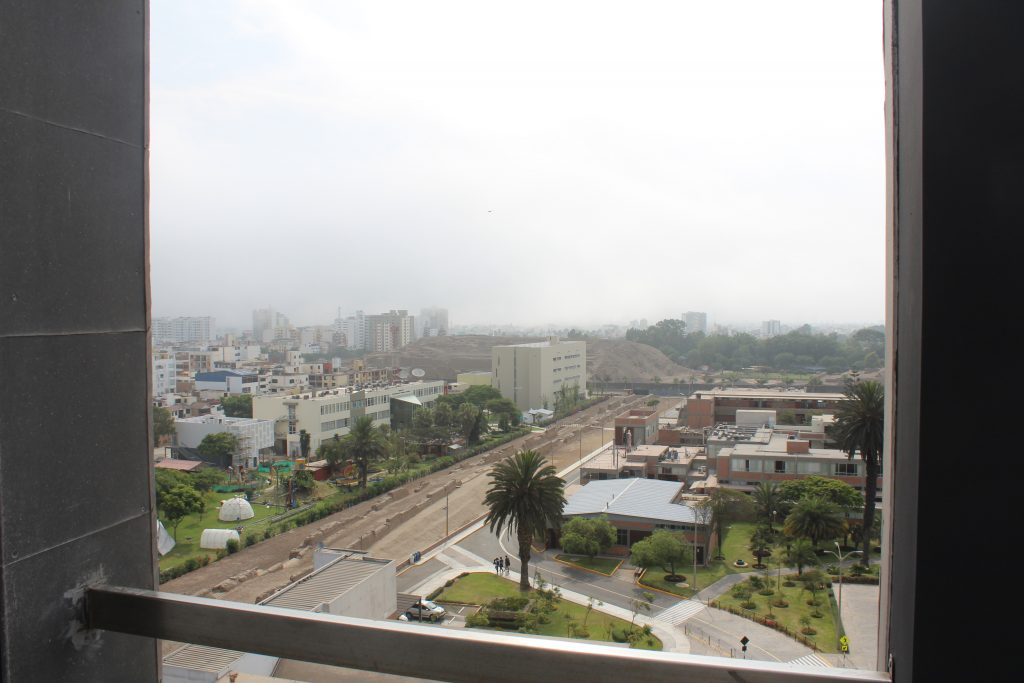
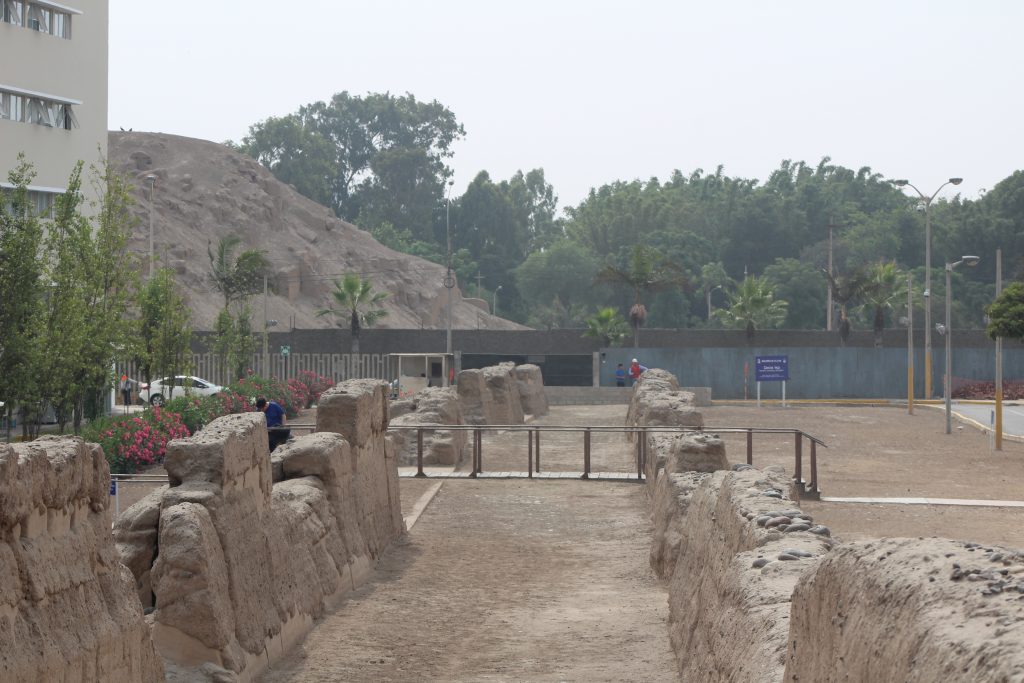
“This road links the pyramids and huacas of Maranga, at the Zoo, with another complex of five flat topped mounds just a few kilometres away at Huaca Mateo Salado,” explains Mayra, “so although its construction appears Inca, they probably refurbished an earlier Ychsma road between neighbouring settlements.”
“The University acquired the land in 1944, when all around was farmland. For years the road split the campus, and students crossed over it by a wooden bridge. Any sign of the road outside the University walls has disappeared.”
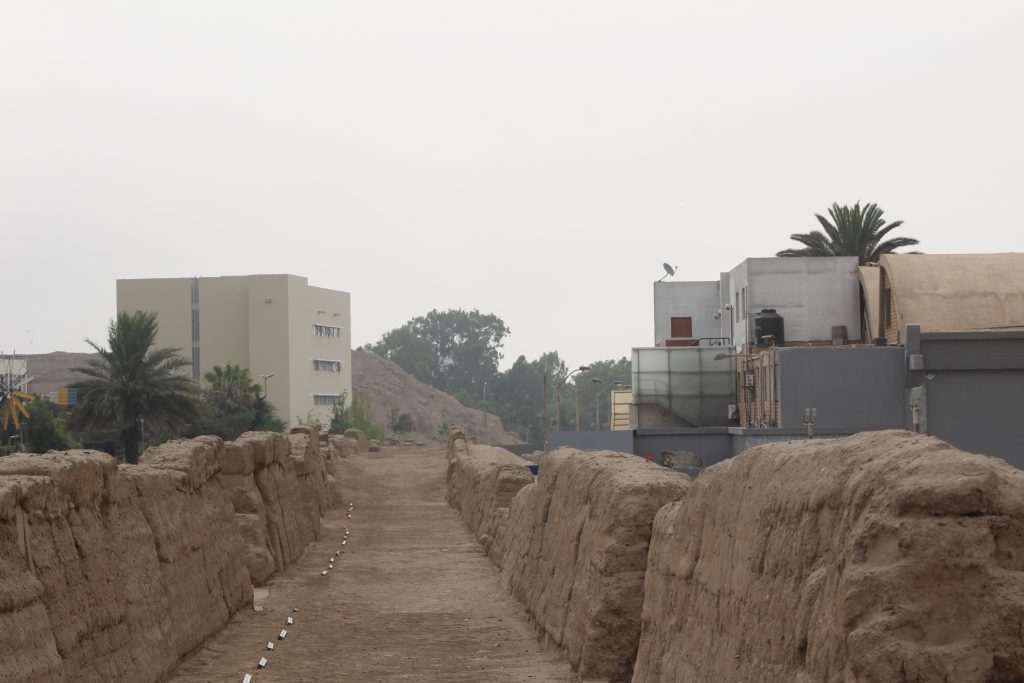
We walk beside the University wall for a few hundred metres to the traffic lights, then turn right, and we are walking down the green central area of a dual carriageway.
“You see these concrete paving slabs in the pathway? Every twenty metres there are loose slabs, with iron clasps to lift them,” says Mayra. “We are walking over a covered waterway, that runs along the centre of the road. This is the route of one of the original thousand year old irrigation canals. It leads to the Maranga complex – it is the same canal we saw inside – and now we are tracing it back from one group of pyramid mounds to the next.”
And through the gaps in the concrete slabs I can see a dark hollow below, and hear the rushing water flowing through.
**********************************************
Aug 27 1998. Fujimori senior visits his children Keiko and Kenji in Boston, where they are studying. Back in Peru, Congress votes narrowly to torpedo a referendum on Fujimori’s attempt on a third consecutive term as President, forbidden by the 1992 Constitution. The referendum is stalled by just four votes: Congressman Luis Chu is bought by “Uncle Vlad” Montesinos with a $130,000 payoff, Miguel Ciccia is bought by buying off pending legal problems.
Nov 21 1998. Former General Rodolfo Robles identifies an individual arrested by police for the intimidatory bombing of a television station studio in Puno as one of the Grupo Colina members. This is the same General Rodolfo Robles who in the May 1993 revealed the involvement of the Grupo Colina in the La Cantuta killings. Five days later army agents seize him on a street in Lima. As he is thrust into a car he calls out “They are from Intelligence. Tell journalist Hildebrandt!” The retired general’s arrest was ordered by a military court.
*********************************************
There are small mounds of adobe beside the road, half concealed amongst the urban development, and as we approach the flag-circled roundabout of the Plaza de la Bandera, a thick high wall of adobe rises up to the left and then, towering over high fencing, a long tall mound can be seen, set back from the road, with tiered layers of adobe brickwork.
The area of protected land here is not as large as the zoo grounds but it is still impressive, more than twice the combined size of the zoo’s botanical gardens and boating lake. There are three large structures ahead, a smaller square mound besides the road, and a fifth tucked away amongst housing two hundred metres to the north-east.
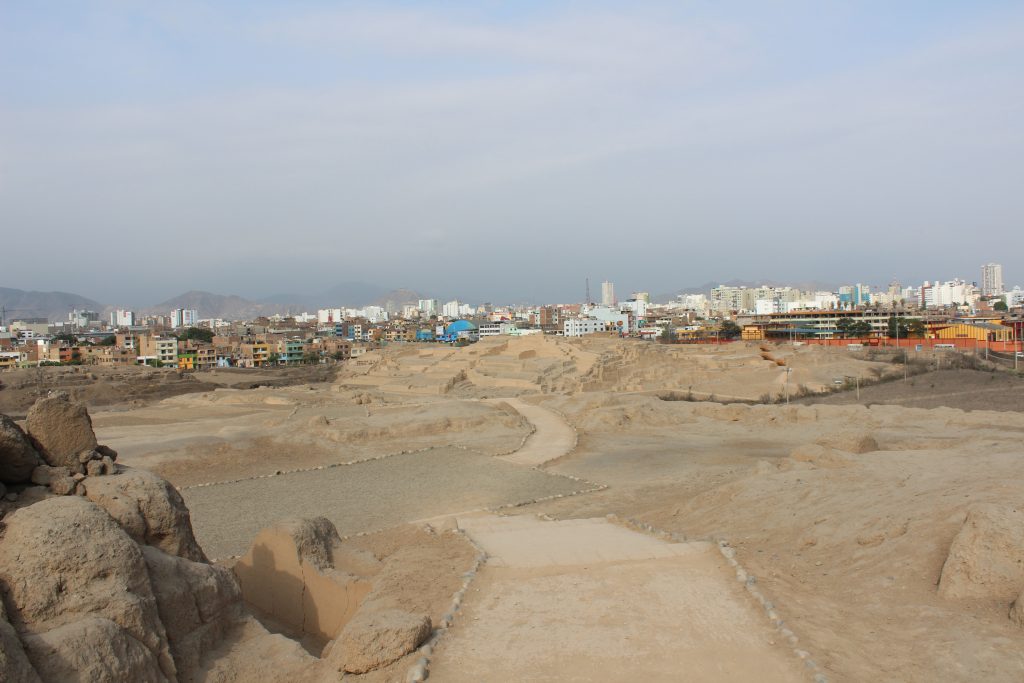
We walk up a wooden stairway leading to the top of the largest mound, from where we can look out over the complex, with the tower blocks of eastern Lima in the background.
“The whole site is considered to be Ychsma,” Mayra tells me, “with ceremonial buildings, temples, houses and offices. And from here they could look north, and wave to the people of Maranga.
“There are nine major canal networks irrigating the whole plain of Lima, and they were here when the Spanish arrived – and long before. For many of them we know the names they had at the time of the invasion.
“The Spanish saw them as chieftaincies under the control of a curaca, a man – always a man – who held sway over territories defined by the irrigation canals they controlled, each of them with their own administrative centre, palace and place of priests. In their eyes, this would be the castle or the hacienda of the Count of Chayacalta, in uneasy truce with the Count of Maranga a couple of kilometres away.
“But that is interpreting what they saw in terms of medieval Spain. Pizarro, the leader of the gang of mercenaries that invaded here, was not spanish – the country did not exist. He was from Castile.
“I prefer to think that the territories, and their administrators, were named after the rivers, which would flow long after individuals had passed away.
“The rivers, the mountains were their gods. They talked to them directly.”
***********************************************
We explore the site, with its fields of roses between the ancient buildings. The dead stumps, with their dried hanging heads, were recently tended here, irrigated by the same canals that brought water to the palaces and houses of the Ychsma.
The National Museum of Anthropology, just eight blocks away, holds the original Stela Raimondi, a polished rock tablet incised with a complex mythical figure of serpentine hair and eagle talons. It also has a powerful recreation of the subterranean chamber of Chavin, with its pillar of rock reaching up from the darkness to the skylight above, intricately carved, the Lanzon, the Lance. Close by is the Museo Larco, with a spectacular collection of ceramics – Moche, Wari, Chimu, Chancay – housed in an old colonial house built atop a pyramid mound.
But we leave and head south west, and in less than an hour we reach the Huaca Hallamarca, whose adobe bricks are not the classic libreria or bookshelf style, but a cruder rounded or conical shape, similar to grains of maize.
The people here had ceramics, cotton textiles, and engraved gourds, but they appear to have been even earlier than the Lima people of Maranga. There are burials on the mounds from the Lima and Ychsma people, but also, confusingly, from Sican and Chancay to the north and Chincha to the south, encompassing 1500 years and nearly 1000 kilometres.
The conical bricks were made by hand rather than with moulds – some bear the hand prints of their makers -and they are identified with a pre-Lima people dated to 2200 BP. At least three more mounds in the city are built this way.
Water flows past the mound, brought by canal from the Rimac – the channels have been recreated in the twentieth century reconstruction of the huaca – and the same channel waters the Lima Golf Course, a private club in the heart of one of the most expensive areas of Lima. Investment banker Pedro Pablo Kuchynski, elected President in 2016, has a house just two blocks from the golf course on Calle Choquehuanca, the street which runs past the Huaca Hallamarca. The polite armed policemen by the side of the road are not protecting the archaeological site.
“The San Isidro district started to demolish the mound in 1941 but were stopped,” Mayra tells me, as we stand on the top looking out over the rooftops, “but after that brickmakers, here and and other ancient sites in Lima, backed up their trucks and loaded up with the adobes as a ready source of clay. The Ministry of Public Works decided to demolish it to make a public park in 1950, but it was saved by an amateur archaeologist.”
Arturo Jiménez Borja managed to get the site declared a protected monument and he reconstructed it, showing more creativity than authenticity, with neat rectangular terraces and an imposing central ramp. It is an attractive site in the middle of an upmarket residential neighbourhood, but it does not have much to tell us.
However, on the other side of the golf course, just one kilometre from the south west corner, we come to the more carefully excavated Huaca Pucclana.
On the roof of the adjacent Clinica Delgado, one of Lima’s most expensive clinics, there is a helicopter landing pad. From up there, we would have a fantastic view. To the south, Parque Kennedy, and Avenida Larco leading down towards the upmarket LarcoMar, a Shopping Mall (US franchises and brand names including Converse sneakers and Hooters sports bar), built into sea cliffs facing the Pacific and looking down on surfers riding the swell one hundred metres below.

To the west, we can see the coastal road which runs twelve kilometres by the pebble beach towards Lima’s port and twin city of Callao, and beyond to the offshore island of El Fronton, traditionally used for political prisoners. To the north west past Bembo’s fast food and the imposing Catholic Church on Ovalo Gutierrez are the tall trees of Lima Golf, the city centre private club past which we have walked. But below us to the north the rooftop looks down on a sprawl of walls, ramps and courtyards made of baked clay bricks at the side of a giant ramped pyramid, two hundred metres long. For today’s visitors it is one of the glories of Lima.
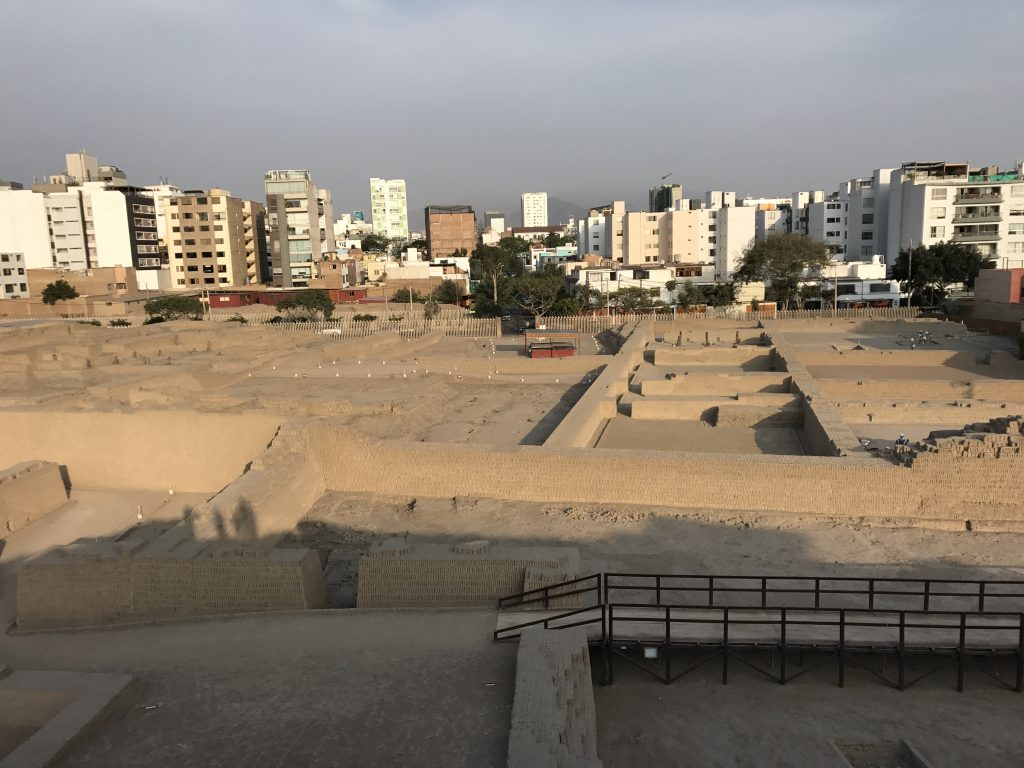
We buy tickets at the entrance and join a dozen tourists for the guided tour, taking a look at the one room museum whilst we wait. It houses giant clay pots decorated with sea lions and sharks, bone tools, a magnificent embroidered shirt, and a weaving kit found in the burials.
The pyramid was built by the Lima people, fifteen hundred years ago, towards the end of the Lima cultural period. The mud bricks appear to have been made on site, perhaps as a form of tax or tribute, says the guide. In a flat space below the pyramid are two small piles of mud baked hard by time and the sun, preserving the footsteps of those who were mixing the clay and water with their feet. The footprints appear tiny, to these European and US visitors, but they are the normal size for the indigenous people of the Andes, then and now.

Tall walls at the front of the pyramid show the bookshelf construction, the libreria, very clearly. The “books” are in rows with spaces between them, each row topped and tailed with a mortar of clay. The rows are assembled one above the other in trapezoid or hexagon forms, and these larger blocks are then fitted together to build the wall. The appearance is spectacular and elegant. If it is true, as the guide suggests, that different families were each asked to contribute a certain amount of adobes, perhaps one trapezoid block of walling, then the structure can be seen as a visual metaphor of how a group of people, a community or society, working together can raise themselves up to “god”.
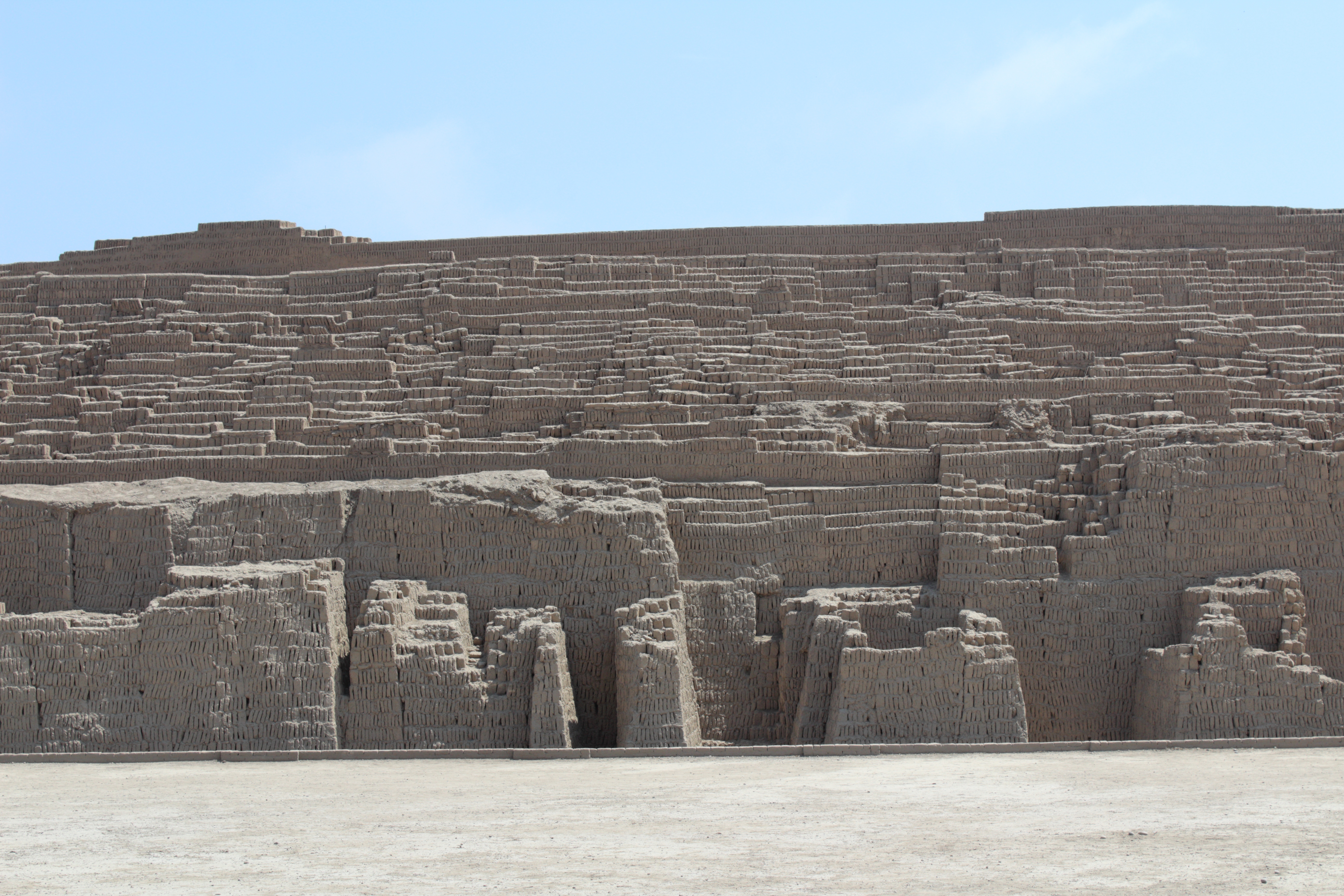
The guide points out how the structure grew over time, with walled rooms being infilled with gravel and stones after a ritual sacrifice: the smashing of a large ceramic pot with a design of a shark or sea lions, sometimes also the sacrifice of a young woman, and big dinners of sea food, particularly shark. Earlier phases of the building use cubic or unshaped blocks, as well as woven cane coated with a layer of adobe by hand. There were ramps to aid the construction which were later demolished, and the mound was completed as a series of terraces, ascending to a peak facing towards the sea less than two kilometres to the south-west.
The main building was built on seven levels or platforms. The guide takes us up a narrow ramp to a fine patio surrounded by low bench walls for seating, yellow paint still visible on the polished clay, with post holes perhaps to hold up a roof for shade, and hundreds of tiny holes in the floor where visitors places their offerings. The third level is similar but smaller, and stairways or restricted passages lead from each level to the next, as a ritual progression.
The upper levels at the far end of the mound are still being excavated, and new burials are found every few years. The burials are Wari.
At some stage in the second half of the first millenium CE, in 700 or 800 CE, there were social changes evident throughout the highlands and the central coast. They appear to relate to the expansion of the Wari people, centred in Ayacucho, and are evident in architecture, ceramics, textiles, iconography, ritual and above all burials.
Some time after the Lima people stopped using the huaca, the Wari came and used it as a burial site. Here and elsewhere around present day Lima they dug into now deserted pyramids to create their own tombs and bury their dead – high status burials, including fishermen, bureaucrats, weavers and priests, wrapped in fine cloths, with ceramics and food to accompany them.
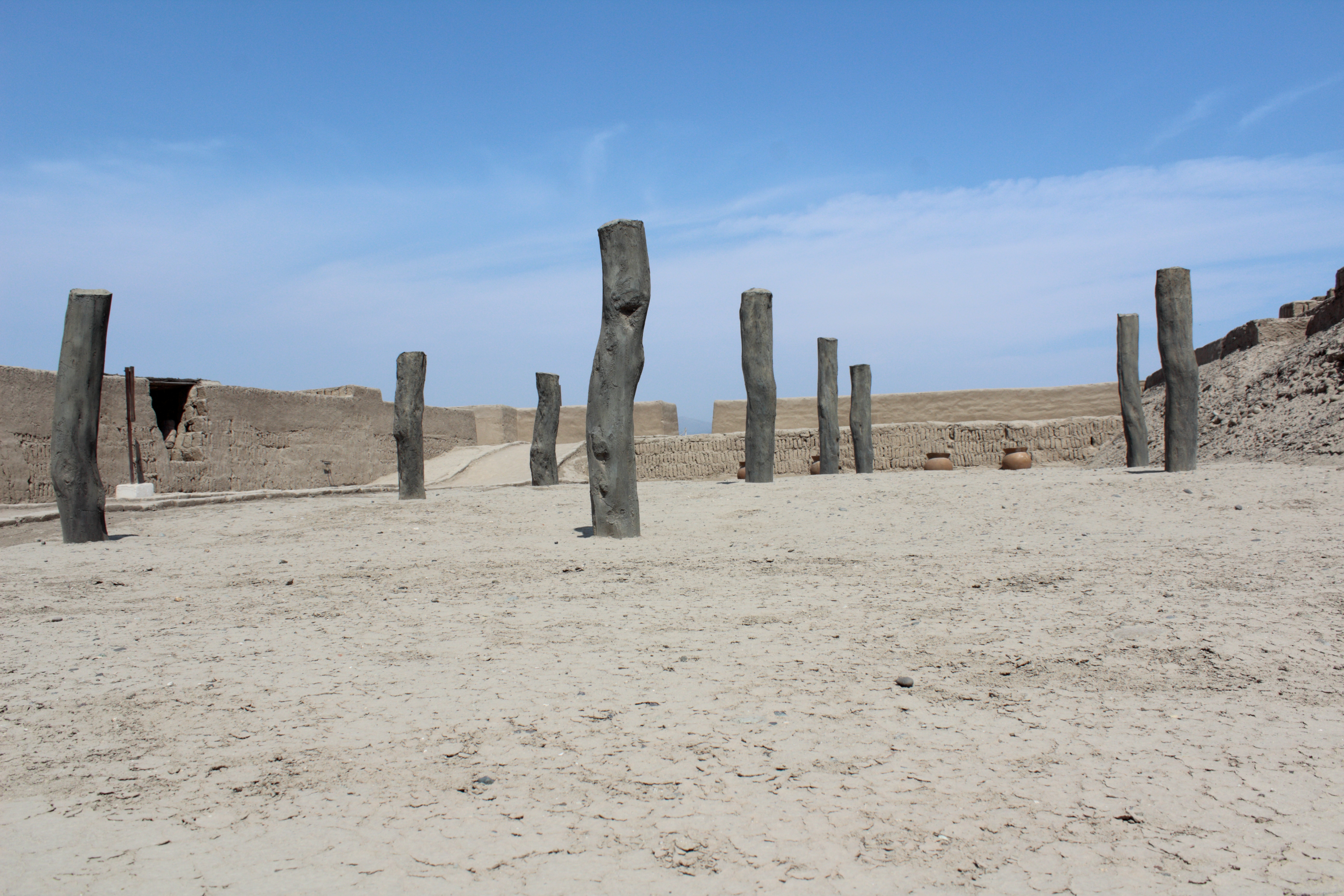
The upper levels of the Huaca built by the Lima people with their plazas and rooms for feasting and offerings were used by the Wari as a ceremonial centre for high status burials.
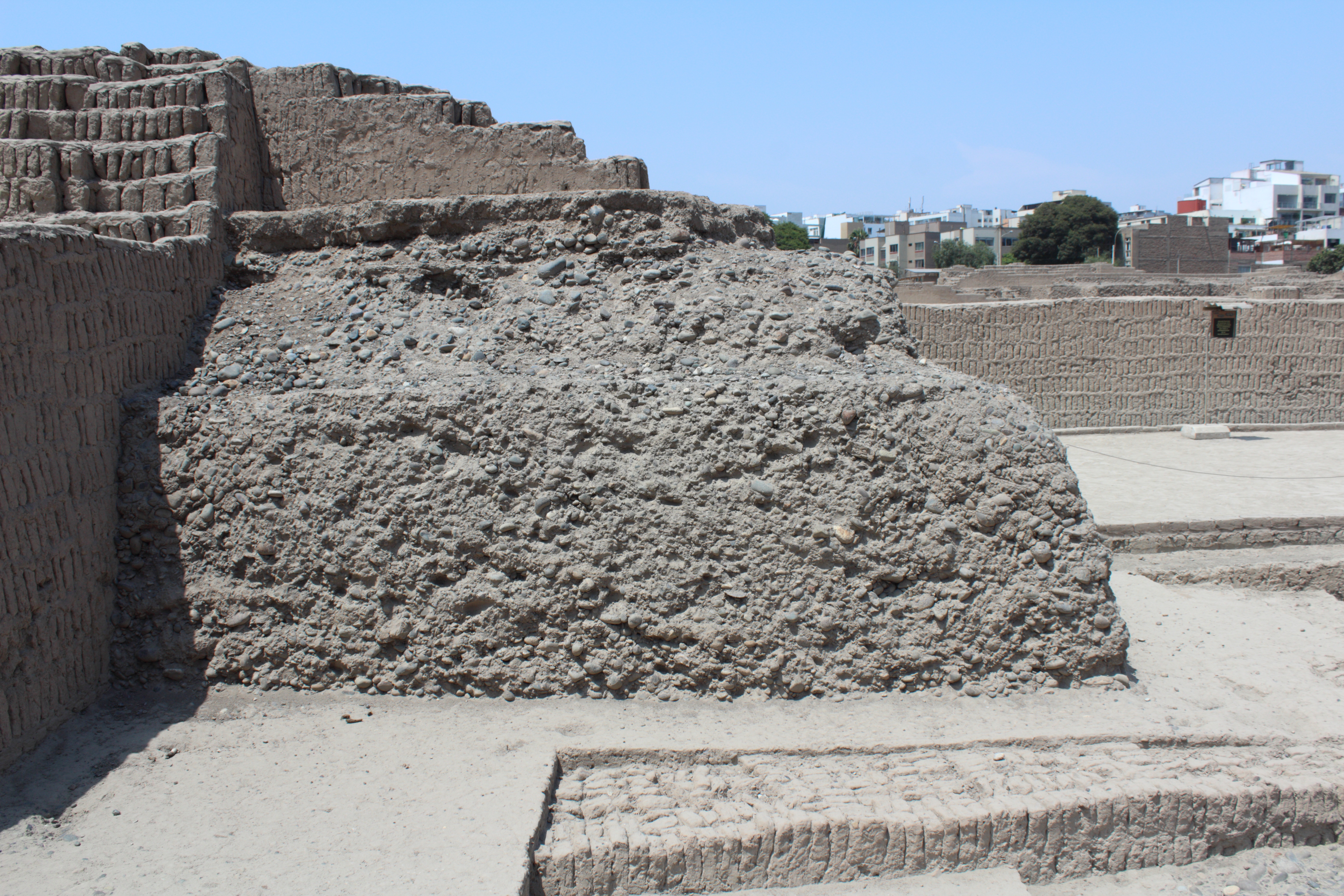
After the tour I sit with Mayra on the patio of the exclusive restaurant looking out over the ruins, sharing a mango milkshake. Parties of tourists from Japan, USA and Europe mix shoulders here with Peruvian lawyers, mafia gangsters, members of congress and narco-traffickers, some of them all four at once.
“So now you know something of the history of the Central Coast,” smiles Mayra. “Lima, Wari, Ychsma, Inca. To keep it simple. One theory is that all these groups of huacas in the coastal plain of the river Rimac, in the present day city of Lima, these ceremonial and administrative mounds, were managed by chiefs who “served” the temple of Pachacamac, on the southern edge of modern Lima, fronting the sea.”

“And what do you think?” I ask.
“I think that reflects the thinking of those brought up in a Spanish colonial world where the catholic church has had similar hierarchical power structures which enmesh with the political powers in the country.”
“But we know that people came to the Pachacamac temple – and left behind their offerings, their textiles and their ceramics – from a great area of present day Peru, from the north and the south, the coast and the highlands,” she continues, “so certainly the people who occupied all these sites, from the earliest of 2000 years BP right up to the Inca, would have recognised the importance of the shrine, or the oracle.”
She takes a sip of milkshake and looks at the diners around.
“The historic route to Pachacamac, at least for the Ychsma peoples here, was through the present day suburbs of Chorillos and Villa Salvador. We could walk it in a day – it is just twenty kilometres. Most Lima people – I mean our companions sipping their cocktails here – believe those neighbourhoods are highly dangerous, bullet riddled and delinquent. But half a million people live there.”
“You ought to see Pachacamac though. And we can take a bus.”
*********************************************************
May 23, 2000. The army high command issues an official statement denouncing “the naturalised Peruvian Baruch Ivcher” for criticising the armed forces. Iver was the head of the TV channel 2 which after being a loyal supporter of the Fujimori regime had begun in late 1995 to investigate the activities of Montesinos and SIN.
September 14, 2000. A cable TV channel broadcasts a video showing Montesinos bribing Congressman Alberto Kouri fifteen thousand dollars to switch his support to Fujimori’s party. The video has been released by Montesinos’ close personal assistant within SIN, Matilde Pinchi Pinchi. Thousands of similar videos are later found: the owners of Channel 2 being offered US$500,000 a month to ban appearances of the political opposition on their channel, Channel 4 owners getting $1.5 million a month for similar cooperation, the owner of Channel 9 receiving $50,000 to cancel an investigative series called SIN Uncensored.
The videos are all taken in the same room with a brown sofa, and a low table. Montesinos sits to one side and places paper bags filled with stacks of dollar bills on the table as he negotiates his bribes. In one such video, Luz Salgado takes part in a meeting and after the guest has left, looks towards the wall and asks Vlad where the camera is.
In 2016 Luz Salgado will be appointed President of Congress by Fuerza Popular.
In September 2000 Alberto Fujimori authorises a payment of US $15 million from the national treasury to Montesinos before he flees to Venezuela in a private yacht, via Galapagos and Costa Rica.
November 13, 2000. Alberto Fujimori leaves the country on a state visit to Brunei. Four days later he travels to Japan, from where he faxes his resignation. Congress refuses to accept his resignation and votes 62-9 to remove him from office on the grounds of disabilidad moral permanente.
Over the next several years, there is a process of national reflection. A Truth and Reconciliation Commision (Commision de Verdad y Reconcilation, CVR) conducts extensive interviews across the country and presents an 8000 page Report, published online in Spanish and English. Legal proceedings are begun against some of those responsible for the abuses of power that have taken place.
The Truth and Reconciliation Commission explains: “in the midst of the urban offensive of the Sendero Luminoso, sectors from all social strata indicated a willingness to exchange democracy for security and tolerate human rights violations as the necessary cost to put an end to subversion.”
In 2006, Alberto Fujimori is arrested in Chile, on the way back to Peru to take part in presidential elections, although he is banned for ten years to stand for any political office. Polls indicate that 12% of the electorate would have voted for Alberto in the 2006 elections if he had stood as a candidate. He is eventually tried and sentenced to 25 years in jail for managing the death squads that carried out the killings of Barrios Altos and La Cantuta, a further seven and a half years for embezzlement of the money given to the fleeing Montesinos, and six years for phone tapping. Other charges are pending.
Fujimori Supporters Slogan 2017 “The Greatest President Peru Ever Had”
